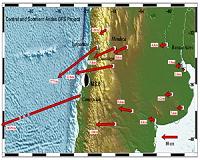| . |  |
. |
Potsdam, Germany (SPX) Mar 16, 2010 The high-magnitude earthquake of 27.2.2010 in southern Central Chile closed one of the two remaining seismic gaps at the South American plate boundary. After the quake of Concepcion, the remaining gap in the north of Chile now holds potential for a comparable strong quake and is, thus, moving more and more into the focus of attention. The GFZ German Research Centre for Geosciences, has been monitoring this gap with the Integrated Plate Boundary Observatory (IPOC) in Chile since 2006. In a festive ceremony on March 15, the Chairman of the Board of the GFZ, Professor Reinhard Huettl, is handing over this Observatory to the Universidad de Chile with the seismological service of Chile and to the Universidad Catolica del Norte. "Together with our Chilean colleagues and other partners we have developed and operated the IPOC. The transfer to the Chilean Earthquake Service will further strengthen this cooperation" explained Reinhard Huettl in Santiago de Chile. "The observatory will continue to be jointly operated, GFZ will finance the German share. The location for this observatory has obviously been very well selected, as the quake of 27 February shows. This last non-ruptured segment of the Earth's crust off the Chilean west coast is highly interesting for geosciences in the whole world". It is, however, not simply a question of earthquakes. The aim is to continuously measure all processes in connection with the dynamics of this plate boundary. Approximately one-third of the world-wide seismic energy has discharged during the last century in earthquakes with magnitudes of over M = 8 along the South American-Pacific plate boundary. The repeat-time between two large earthquakes is shorter here than almost anywhere else on our planet. The IPOC project investigates the area around Iquique on the South American Nazca Plate Boundary. One expects that within the next years a strong to devastating earthquake will occur in this area. Within the framework of investigations, deformation, seismicity, and magnetotelluric fields in the subduction zone will be monitored, i.e. in the periods before, between and possibly also during a quake. The equipping of the observatory began in close collaboration with the Universidad de Chile (Santiago), the Universidad Catolica del Norte (Antofagasta), the IPGP (Paris) and the GFZ (Potsdam). Professor Onno Oncken, Director of the Department "Geodynamics and Geomaterials" at the GFZ (Helmholtz Association) is coordinator of the IPOC activities and explains the construction of the observatory: "Currently the monitoring network consists of 20 seismological stations, equipped with broadband seismometers and acceleration sensors". In order to do justice to the requirements for dissolution and efficiency of the sensors and data capture, special care was given to choosing the exact location. Thus, at each station a lug of approx. 5 m deep was blown into the rock bed, in order to ensure stable site conditions for the monitoring instruments. All seismic installations are equipped with the new-generation GPS-instruments. Seven measuring points were furthermore equipped beyond that with magnetotelluric measuring instruments and serve for the measurement of electric current in the Earth's crust. Professor Oncken has been leading research on geodynamics in the Andes since 1994. These investigations are not only of geoscientific interest. "Due to the numerous expeditions and measuring campaigns over the years in this subduction zone, the GFZ now holds the densest data set world-wide for such an area" says Onno Oncken. "When we monitor the conditions before, during and after a large quake this serves to help develop a hazard model for this and similar regions. A strong quake in this region can have consequences for the global economy: the earthquakes here develop through the subduction of the Pacific-floor under South America. The same process also leads to the formation of ore deposits in the Earth's crust. Thus, the largest copper deposit of the world is to be found on the western boundary of the Central Andes. A strong quake could interrupt or even endanger the global supply of copper and lithium.
Share This Article With Planet Earth
Related Links Helmholtz Association of German Research Centres Tectonic Science and News
 Cities In Motion
Cities In MotionColumbus OH (SPX) Mar 09, 2010 The massive magnitude 8.8 earthquake that struck the west coast of Chile last month moved the entire city of Concepcion at least 10 feet to the west, and shifted other parts of South America as far apart as the Falkland Islands and Fortaleza, Brazil. These preliminary measurements, produced from data gathered by researchers from four universities and several agencies, including geophysicis ... read more |
|
| The content herein, unless otherwise known to be public domain, are Copyright 1995-2010 - SpaceDaily. AFP and UPI Wire Stories are copyright Agence France-Presse and United Press International. ESA Portal Reports are copyright European Space Agency. All NASA sourced material is public domain. Additional copyrights may apply in whole or part to other bona fide parties. Advertising does not imply endorsement,agreement or approval of any opinions, statements or information provided by SpaceDaily on any Web page published or hosted by SpaceDaily. Privacy Statement |